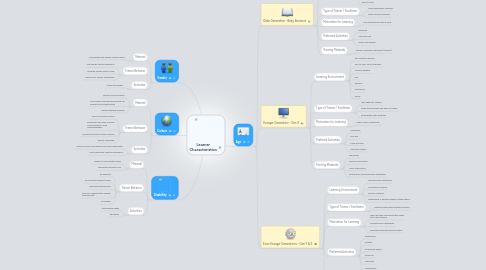
1. Age
1.1. Older Generation - Baby Boomers
1.1.1. Learning Environment
1.1.1.1. Interactive
1.1.1.2. Non-Authoritarian
1.1.1.3. Teamwork
1.1.1.4. Networking Opportunities
1.1.1.5. Face-to-Face
1.1.2. Type of Trainer / Facilitator
1.1.2.1. Views Participants as Equals
1.1.2.2. Share Personal Examples
1.1.3. Motivation for Learning
1.1.3.1. Will Help them be Stars at Work
1.1.4. Preferred Acitvities
1.1.4.1. Interacive
1.1.4.2. Hate Role Play
1.1.4.3. Wants Skill-Building
1.1.5. Training Materials
1.1.5.1. Readily Accessible Information (internet)
1.2. Younger Generation - Gen X
1.2.1. Leraning Environment
1.2.1.1. Self-Directed Learning
1.2.1.2. Two-to-Four-Hours Segments
1.2.1.3. Honest Feedback
1.2.1.4. Fun
1.2.1.5. Personal
1.2.1.6. Fast-Paced
1.2.1.7. Online
1.2.2. Type of Trainer / Facilitator
1.2.2.1. Gets Right into Material
1.2.2.2. Gives Solid Examples and Real-Life Cases
1.2.2.3. Demonstrate Their Expertise
1.2.3. Motivation for Learning
1.2.3.1. Adds to their Marketability
1.2.4. Prefered Activities
1.2.4.1. Simulations
1.2.4.2. Role Play
1.2.4.3. Learn by Doing
1.2.4.4. Discovery Method
1.2.5. Training Materials
1.2.5.1. Few Words
1.2.5.2. Chunk of Information
1.2.5.3. Visual Stimulations
1.2.5.4. Synchronous Communication Capabilities
1.3. Even Younger Generations - Gen Y & Z
1.3.1. Learning Environment
1.3.1.1. Teamwork with Technology
1.3.1.2. Cooperative Learning
1.3.1.3. Learner-Centered
1.3.1.4. Download to in Delivery Medium of their Choice
1.3.2. Type of Trainer / Facilitator
1.3.2.1. Authority Figure who Provides Structure
1.3.3. Motivation for Learning
1.3.3.1. Learn Skills and Information that Makes Work Less Stressful
1.3.3.2. Increases their Marketability
1.3.3.3. Helps them deal with Difficult People
1.3.4. Preferred Activities
1.3.4.1. Entertaining
1.3.4.2. Creative
1.3.4.3. Incorporate Games
1.3.4.4. Hands-On
1.3.4.5. Interactive
1.3.4.6. Collaborative
1.3.5. Training Materials
1.3.5.1. Lively and Varied
1.3.5.2. Graphics
1.3.5.3. Reprints of Articles and Job Aids
1.3.5.4. On Social Network
2. Gender
2.1. Material
2.1.1. Case Studies use Gender-Neutral names
2.2. Trainer Behavior
2.2.1. Use Gender Neutral References
2.2.2. Get Both Gender Point of View
2.2.3. Refrain from Gender Stereotypes
2.3. Activities
2.3.1. Group Mix Gender
3. Culture
3.1. Material
3.1.1. Reflect Various Cultures
3.1.2. Case Studies use Names Reflecting the Diversity of the Organization
3.1.3. Videos Reflecting Diversity
3.2. Trainer Behavior
3.2.1. Learn to Pronouce Names
3.2.2. Be Familiar how Other Cultures Communicate to avoid Misinterpretation
3.2.3. Ask Questions about Other Customs
3.2.4. Refrain Stereotype
3.3. Activities
3.3.1. Certain Cultures May required More Encouragements
3.3.2. Use Cooperative-Learning Techniques
4. Disablility
4.1. Material
4.1.1. Modifiy to Accomodate Needs
4.1.2. Appropriate Reading Level
4.2. Trainer Behavior
4.2.1. Be Sensitive
4.2.2. Accomodate Different Needs
4.2.3. Treat like Everybody Else
4.2.4. Find out in Advance (pre-session questionnaire)
4.2.5. Be Flexible
4.3. Activities
4.3.1. Accomodate Needs
4.3.2. Be Flexible

